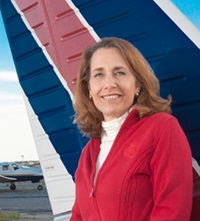

Kathy Yodice
- Attorney, Counsel to AOPA
- Former FAA attorney
- Has assisted AOPA members for more than 16 years
- Pilot since 1994, owns a Cherokee 180
Briefing. Under FAR 91.107(a)(1), the pilot in command is responsible for ensuring “that each person on board the aircraft is briefed on how to fasten and unfasten that person’s safety belt and, if installed, shoulder harness” before takeoff. The regulation does not require that the pilot in command personally conduct the briefing, only that the pilot in command make sure that a briefing is given. This is a regulation that is too easily forgotten or ignored and could be vital to the inexperienced passenger. This may seem unnecessary but remember that aviation seatbelts can be quite different than cars so in an emergency, a panicky passenger might struggle to get out of his or her seat belt.
Notification. In addition to the briefing, FAR 91.107(a)(2) requires that the pilot in command ensure “that each person on board has been notified to fasten his or her safety belt and, if installed, his or her shoulder harness” prior to aircraft movement on the surface, before takeoff, and before landing. Note that while the briefing aspect of the regulations applies only to takeoffs, the notification responsibility applies to both takeoffs and landings, and it also applies to the movement of the aircraft on the surface. Again, the pilot in command need not personally accomplish this notification so long as the pilot in command makes sure that the notification has been given.
Use. For use requirements, there’s a distinction between crewmember use and passenger use.
For crewmember use, the regulations refer to “required flight crewmember,” which for us is usually only one person--the pilot in command of the flight. FAR 91.105(a) says that each required flight crewmember must keep his or her seat belt fastened during takeoff and landing, and while en route. FAR 91.105(b) says that during takeoff and landing, the required flight crewmember must keep his or her shoulder harness fastened while at the crewmember stations, but need not keep it fastened while en route. The harness requirement only applies if the crewmember’s seat is, in fact, equipped with a shoulder harness. There is an exception that might apply to our single-pilot, small aircraft operations. Because a shoulder harness may interfere with piloting duties, the regulations do not mandate that a required flight crewmember must fasten the shoulder harness if the pilot would be unable to perform required duties with the shoulder harness fastened.
For most passengers, FAR 91.107(a)(3) requires similar use requirements to that of the pilot, with two exceptions. In addition to takeoffs and landings, passengers must also use their seat belts and shoulder harnesses during aircraft movement on the surface. However, passengers are not required to use seat belts or shoulder harnesses while en route, although it is probably a good idea for those passengers to do so. Note that these are use requirements for passengers to comply with, not the pilot in command. As the pilot, it is your responsibility to ensure that each person on board is briefed about the use of belts and harnesses and that each person is notified to fasten his or her belt and harness, but it is not your responsibility to ensure that the passenger uses them.
For some other passengers, there are exceptions. For example, an exception to seating and belt requirements is that a child under the age of two may be held by an adult who is occupying an approved seat or berth. The FAA has also recognized an exception that allows two people to occupy one seat; according to the FAA, use of a seat belt and seat by more than one occupant is appropriate as long as the belt was approved and rated for such use, the structural strength requirements for the seats are not exceeded, and the seat usage conforms with the limitations of the airplane flight manual. And, a person on board for the purpose of engaging in sport parachuting still needs to be belted and harnessed, if installed, but may use the floor of the aircraft as a seat.
In my experience, pilots are better able to remember these briefing, notification, and use requirements if they are included on a checklist. So, think about adding them to your checklists. And, don’t presume the knowledge of your passengers. It’s always better to be safe (and compliant) than sorry.
To learn more about the Pilot Protection Services program, visit the website.
To continue reading, please log in or join AOPA now to have access to these exclusive expert resources.
As pilot in command of an aircraft, you have a lot of responsibility, especially when you have passengers aboard. Not only must you make sure you are buckled up, but the regulations require that you must also assure that your passengers are buckled up and you must be sure to brief them. I find that the requirements are easiest to remember as a “Rule of Three”: briefing, notification, and use.



